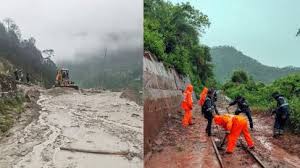India Weather Today Live Updates: Kedarnath yatra temporarily suspended after landslide; IMD issues flash-flood warnings in Himachal

India Weather Today: Kedarnath Yatra Halted After Landslide; Flash Floods Ravage Himachal Pradesh
Date: July 3, 2025
Heavy monsoon rain continues to batter northern India. Uttarakhand and Himachal Pradesh are the worst affected. The Kedarnath Yatra has been temporarily halted after a major landslide near Sonprayag. Meanwhile, Himachal faces widespread destruction caused by flash floods and landslides.
⚠ Kedarnath Yatra Stopped After Landslide at Sonprayag
In Uttarakhand, a landslide struck early Thursday near Munkatiya, close to Sonprayag. The debris completely blocked the route to Kedarnath Dham. Authorities suspended the pilgrimage to prevent casualties and ensure safety.
Overnight rain caused the landslide. The State Disaster Response Force (SDRF) quickly evacuated around 40 stranded devotees. No injuries have been reported so far.
Officials confirmed that the yatra will remain suspended until the path is cleared and declared safe.
“Devotee safety is our top priority,” said a Rudraprayag district official. “We have started clearing operations, but the rain remains unpredictable.”
🏔 Himachal Pradesh Faces Red Alert as Flash Floods Hit Mandi and Shimla
Himachal Pradesh is grappling with one of its worst monsoon spells in recent years. The India Meteorological Department (IMD) issued red alerts for Shimla, Mandi, Kangra, and Kullu. The warning highlights the risk of flash floods, overflowing rivers, and landslides.
In Mandi, a cloudburst on Wednesday night killed four people. Sixteen others are missing. The sudden flood swept away homes, bridges, and vehicles.
Videos show powerful water currents washing away roads and property. Entire villages have been cut off. Rescue teams are struggling to reach remote regions.
Shimla saw the collapse of a five-storey building due to ground instability. Fortunately, the building was evacuated hours earlier. Authorities have closed highways in several places to prevent accidents.
📚 Schools Closed, Travel Discouraged
Officials shut schools in several districts, including Mandi and Shimla. They also canceled exams and advised residents to avoid travel unless absolutely necessary.
More than 250 roads remain blocked. Key routes like the Shimla-Chandigarh and Manali-Leh highways are inaccessible. This has delayed rescue operations and left travelers stranded.
Power lines have suffered major damage. Many regions face blackouts and water shortages. Relief teams are setting up camps in safer locations and sending essential supplies by air.
🌧 IMD Forecast: Heavy Rain to Continue Till July 5
The IMD has predicted continued heavy rainfall until July 5 across north India. Uttarakhand, Himachal, and parts of West Bengal are likely to see intense rain and storms.
Flash flood alerts remain active in the catchment zones of the Ravi, Beas, and Sutlej rivers. These rivers are already nearing dangerous levels.
🧭 Safety Tips for Locals and Pilgrims
Authorities have issued safety guidelines to prevent loss of life. They urge everyone to:
- Stay away from rivers, hill edges, and unstable ground
- Avoid crossing flooded roads or streams
- Travel only after checking official updates
- Keep emergency supplies ready
- Follow evacuation instructions without delay
Pilgrims planning to visit Kedarnath, Badrinath, or other Char Dham sites should postpone their plans until conditions improve.
🏞 Environmental Concerns: Is the Hill Infrastructure Crumbling?
Frequent landslides and flash floods point to a bigger problem—unsustainable development in the hills. Experts have warned against rampant construction and deforestation in eco-sensitive zones.
Dr. Anita Rawat, a geologist from Dehradun, said,
“The mountains can no longer absorb such heavy rain. We’ve altered the natural drainage and disturbed the soil.”
Projects like road-widening and dam construction have made the slopes weaker. With each passing year, monsoon damage is getting worse.
🌍 Final Thoughts: Caution and Climate Action Needed
The weather crisis in Uttarakhand and Himachal is not a one-off event. It’s part of a growing pattern tied to climate change and poor planning.
While rescue operations are ongoing, experts stress the need for long-term action. Early warning systems, climate-resilient roads, and eco-sensitive tourism policies must become top priorities.
Until then, residents and travelers must stay alert and follow safety protocols. Lives can be saved through better awareness and quick response.






